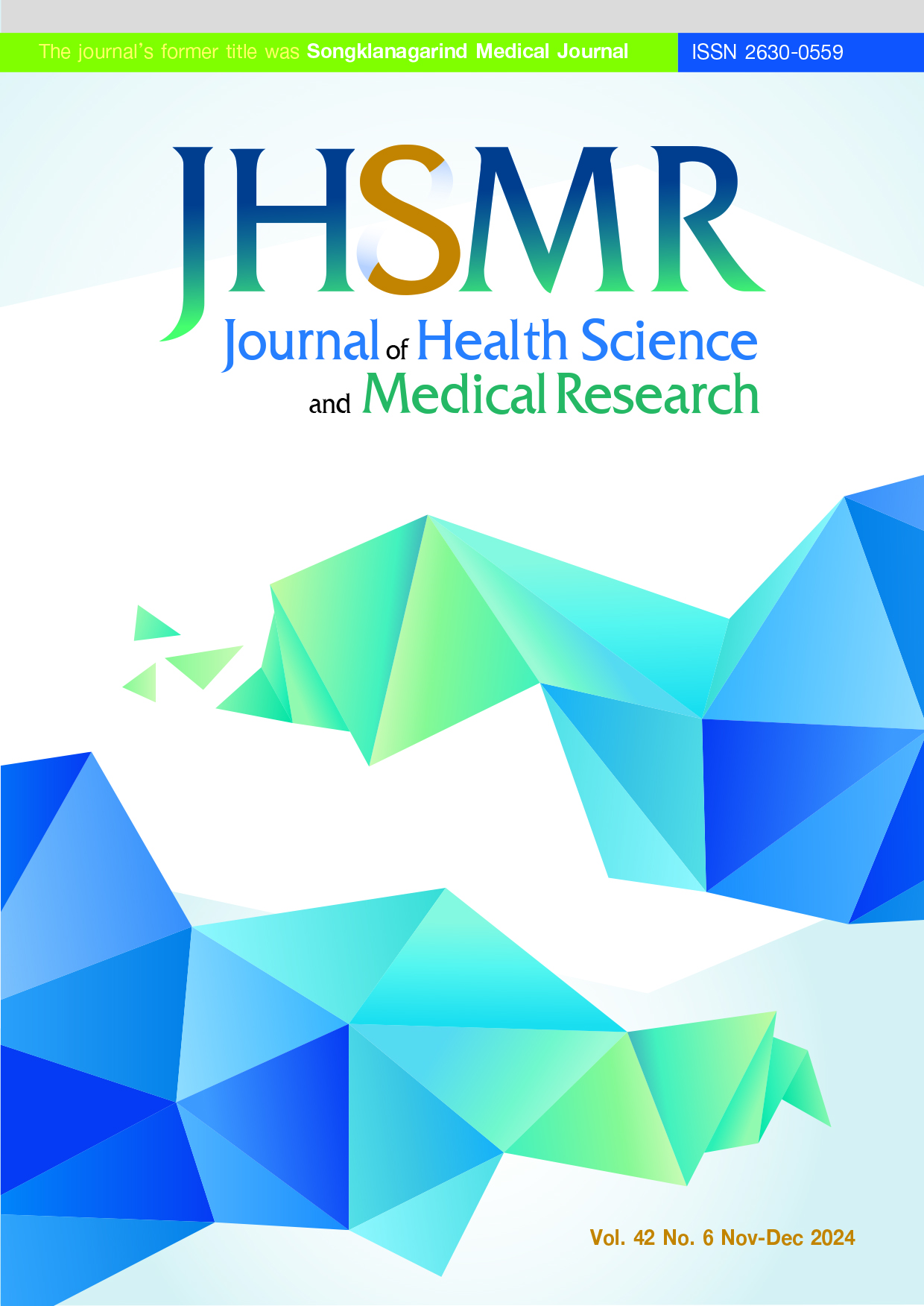Changes in Intraocular Pressure While Using Electronic Devices in Sitting and Supine Positions
DOI:
https://doi.org/10.31584/jhsmr.20241096Keywords:
electronic devices, intraocular pressure, sitting, supineAbstract
Objective: This study aimed to compare intraocular pressure (IOP) measurements in sitting and supine positions while exposed to electronic devices.
Material and Methods: A total of 26 participants (52 eyes) had their IOP measured by Keeler Pulairs tonometer in sitting and supine positions both before and after using a mobile phone. The IOP was initially measured while sitting, followed by 2 minutes in a supine position. The IOP was then measured again after watching the movie for 30 minutes in each position under daylight conditions. Postural IOP changes due to exposure to electronic devices were measured and compared.
Results: The IOP exhibited a statistically significant increase (p-value<0.05) in the supine position compared to the sitting position, both before and after exposure to the electronic device. Following a 30-minute period of exposure, the IOP was significantly reduced by 0.7 mmHg in the sitting position (from 12.7 mmHg to 12.0 mmHg, p-value<0.05). However, there were no significant differences observed in the supine position (13.3 mmHg versus 13.3 mmHg, p-value>0.05).
Conclusion: Different postural positions have an effect on IOP, as IOP is higher in the supine position than in the seated position. There was a decline in the IOP after 30 minutes of exposure in the sitting position. However, there are no changes in IOP that occur in the supine position. These findings suggest a potential link between mobile phone usage and postural changes in IOP, which could have implications for ocular health in individuals who frequently use mobile devices.
References
Department of Statistics Malaysia. ICT Use and Access By Individuals and Households Survey Report, Malaysia, 2021 [homepage on the Internet]. Wilayah Persekutuan Putrajaya: Ministry of Economy; 2022 [cited 2024 Mar 29]. Available from: https://www.dosm.gov.my/portal-main/release-content/ict-use-and-access-by-individuals-and-households-survey-report-malaysia-2021
Munshi S, Varghese A, Dhar-Munshi S. Computer vision syndrome-A common cause of unexplained visual symptoms in the modern era. Int J Clin Pract 2017;71.
Liu Y, Lv H, Jiang X, Hu X, Zhang M, Li X. Intraocular pressure changes during accommodation in progressing myopes, stable myopes and emmetropes. PLoS One 2015;10:1–7.
Qudsiya SM, Khatoon F, Khader AA, Asghar M, Abdul M, Hazari H, et al. Original research article study of intraocular pressure among individuals working on computer screens for long hours. Ann Med Physiol 2017;1:22–5.
Ha A, Kim YK, Park YJ, Jeoung JW, Park KH. Intraocular pressure change during reading or writing on smartphone. PLoS One 2018;13:e0206061.
Lam A, Wu YF, Wong LY, Ho NL. IOP variations from sitting to supine postures determined by rebound tonometer. J Optom 2013;6:95–100.
Jasien JV, Jonas JB, Gustavo De Moraes C, Ritch R. Intraocular pressure rise in subjects with and without glaucoma during four common yoga positions. PLoS One 2015;10:1–9.
Hashemi H, Khabazkhoob M, Nabovati P, Yazdani N, Ostadimoghaddam H, Shiralivand E, et al. Distribution of IOP measured with an air puff tonometer in a young population. J Curr Ophthalmol 2018;30:35–41.
Wozniak K, Köller AU, Spörl E, Böhm AG, Pillunat LE. Intraocular pressure measurement during the day and night for glaucoma patients and normal controls using Goldmann and Perkins applanation tonometry. Ophthalmologe 2006;103:1027–31.
Straker LM, Coleman J, Skoss R, Maslen BA, Burgess-Limerick R, Pollock CM. A comparison of posture and muscle activity during tablet computer, desktop computer and paper use by young children. Ergonomics 2008;51:540–55.
Sultan M, Blondeau P. Episcleral venous pressure in younger and older subjects in the sitting and supine positions. J Glaucoma 2003;12:370–3.
Malihi M, Sit AJ. Effect of head and body position on intraocular pressure. Ophthalmology 2012;119:987–91.
Shrestha R, Patyal S, Bista R, Rajkarnikar S, Gurung A. Effect of posture in intraocular pressure, comparison between normal and glaucomatous subjects. Med J Shree Birendra Hosp 2012;11:21–3.
Najmanová E, Pluháček F, Haklová M. Intraocular pressure response affected by changing of sitting and supine positions. Acta Ophthalmol 2020;98:e368.
Lindén C, Qvarlander S, Jóhannesson G, Johansson E, Östlund F, Malm J, et al. Normal-tension glaucoma has normal intracranial pressure: a prospective study of intracranial pressure and intraocular pressure in different body positions. Ophthalmology 2018;125:361–8.
Hirooka K, Shiraga F. Relationship between postural change of the intraocular pressure and visual field loss in primary open-angle glaucoma. J Glaucoma 2003;12:379–82.
Qudsiya SM, Khatoon F, Khader AA, Ali MA, Hazari MAH, Sultana F, et al. Study of intraocular pressure among individuals working on computer screens for long hours. Ann Med Physiol 2017;1:22–5.
Niesłuchowska M. Work with visual display units and its effect on the eye. Klin Ocz 2007;109:30–4.
Pas-Wyroślak A, Wagrowska-Koski E, Jurowski P. Assessment of the impact of the visual work with display monitors on the eye temperature and intraocular pressure. Med Pr 2010;61:625–33.
Pakravan M, Samaeili A, Esfandiari H, Hassanpour K, Hooshmandi S, Yazdani S, et al. The influence of near vision tasks on intraocular pressure in normal subjects and glaucoma patients. J Ophthalmic Vis Res 2022;17:497–504.
Gallar J, Liu JHK, Liu J. Stimulation of the cervical sympathetic nerves increases intraocular pressure. Invest Ophthalmol Vis Sci 1993;34:596–605.
Malihi M, Sit AJ. Effect of head and body position on intraocular pressure. Ophthalmology 2012;119:987–91.
Bababekova Y, Rosenfield M, Hue JE, Huang RR. Font size and viewing distance of handheld smart phones. Optom Vis Sci 2011;88:795–7.
Yoshimura M, Kitazawa M, Maeda Y, Mimura M, Tsubota K, Kishimoto T. Smartphone viewing distance and sleep: an experimental study utilizing motion capture technology. Nat Sci Sleep 2017;9:59–65.
Downloads
Published
How to Cite
Issue
Section
License

This work is licensed under a Creative Commons Attribution-NonCommercial-NoDerivatives 4.0 International License.
























